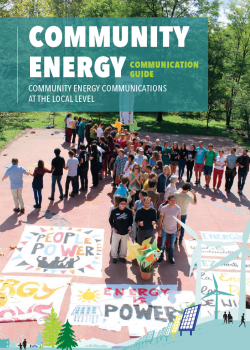Community Energy Communication Guide
Your go-to guide to community energy communications at local level!

This Communication Guide complements the publication “Community Energy – A practical guide to reclaiming power”. The Community Energy guide, published in 2019 by Friends of the Earth Europe, REScoop.eu and Energy Cities, explains the European context in which the Community Power movement operates, and highlights the benefits of community energy. It also presents the different steps to set up your community energy project, which is why you won’t find this information in this document. If you are not familiar with the topic of community energy, we recommend you read “Community Energy – A practical guide to reclaiming power“ before reading this Communication Guide.
Today, many people still don’t know what community energy is and the benefits it can offer in collectively addressing climate and social challenges. Spreading the word about community energy is thus an important aspect of leading the transition to energy democracy.
In this short Communication Guide, Energy Cities & RESCoop.eu attempt to answer the most common questions received from citizen groups and local governments that wish to:
- gain support for the launch of their community energy project;
- motivate their residents, neighbours and stakeholders to take part in their project
This Guide will help non-experts in communications to gain an initial understanding of the topic, enough to kick off communication and engagement activities for the development of local community energy projects. It will inspire them with numerous examples of cities and cooperatives that went before them and succeeded!
How to read and use this Guide?
We decided to focus on the aspects of communication that, based on our experience, could be useful to someone wanting to start a community energy project. Nevertheless, Chapter 1 will present a general overview of the main steps in developing a communication strategy; these tend to be similar for most projects and sectors. In the following chapters, we will go into the details of communicating about community energy. You will read about hopeful storytelling, an important tool for activists to reinforce their narrative (Chapter 2), and how to engage your community (Chapter 3), ensuring your communication can inspire the necessary action to make your collective renewable energy project a reality. Chapter 4 focuses on how local authorities and cooperatives can use their respective strengths to successfully plan and implement communication actions. Finally, we bring everything together in Chapter 5 in order to guide you through what is probably the most important tool for #communitypower communication: a community energy campaign.
